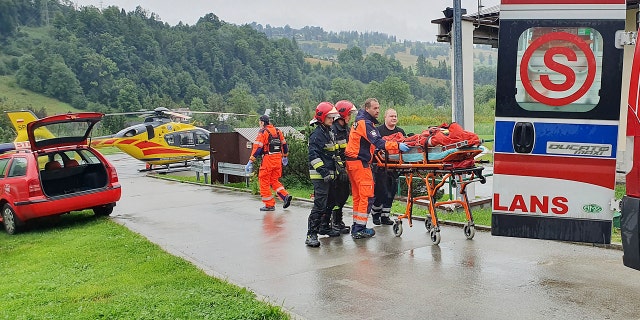Inclement Weather on Mountain Peaks
"[We were halfway up Giewont peak in clear weather when suddenly we heard thunder and thought it was a jet overhead]. But soon lightning struck and we turned back. "
"Suddenly it started pouring and you could hear thunder roaring from every possible direction."
Tourist Grzegorz Pyzel
"At least a dozen people were hit by lightning in the vicinity of Giewont mountain. There are also several deaths in several places in the Tatras."
Polish Air Rescue Service (LPR)
"As far as we know four people did not survive these rapid, unusual, very rare lightning discharges."
"[The services: Tatra Volunteer Search and Rescue] carried out the mission of rescuing all those who had been injured very professionally."
"Nobody expected such a sudden storm to break out."
Poland’s PM Mateusz Morawiecki
"[Lightning typically strikes tall objects such as trees and skyscrapers because their tops are closer to the base of the storm cloud]. However, this does not always mean tall objects will be struck. It all depends on where the charges accumulate."
"Lightning can strike the ground in an open field even if the tree line is close by."
"[Lightning also can strike from as far away as 25 miles from a thunderstorm cloud, even when there appear to be clear skies]. They can be especially dangerous because they appear to come from clear blue sky."
National Severe Storms Laboratory
 |
| Rescue crews with the first people injured by a lightning strike that struck in Poland's southern Tatra Mountains during a sudden thunderstorm Thursday. (AP Photo/Bartlomiej Jurecki) |
"There were a few deaths in different parts of the Tatra mountains."The Tatras, part of the Carpathian mountain range, are the highest mountains in Poland and in Slovakia, bringing tourists to the peerless landscape to view the scenic lakes and peaks soaring majestically to 2,655 meters (8,710 feet). On Thursday the peace and tranquility of the idyllic landscape was transformed completely. Out of a clear blue sky and a tourist's sense of absolute perfection, came death and destruction.
"We heard that after [the] lightning struck, people fell … The current then continued along the chains securing the ascent, striking everyone along the way. It looked bad."
Jan Krzysztof, Polish mountain rescue service chief
Out of the perfection of an ocean of blue a thunderstorm suddenly struck. It left five people -- including two children -- dead; four in Poland, the fifth in Slovakia. According to the Slovak rescue service, a Czech tourist was killed when lightning threw him off Banikov peak, sending him spiralling hundreds of meters down the mountainside. In the Tatra Mountains, emergency workers were searching the whereabouts of two cave spelunkers who were trapped by rising water.
The rescuers widened passages in uncharted portions of the Wielka Sniezna cave -- the deepest and longest in Poland -- with the use of small amounts of explosives in their search for the missing cavers. "The first of the cavers has been found in the cave, he is dead. More information will be available tomorrow", announced the Polish Tatra emergency service, known as TOPR
When lightning struck, it hit the 15-metre-tall iron cross that had been erected at the summit in 1901. The presence of the cross is known to attract lightning. And when lightning struck on Giewont summit, hitting the cross, it was thought by rescuers that there were many hikers in its near proximity, accounting for some among the hundred people said to have been injured, some by falling rock, others by falling onto the rocky surface.
Setting out to climb Poland's highest peaks at a time of clear skies early in the day, none would have expected to encounter a violent thunderstorm. But this is a mountain range, after all, and clouds become marooned over mountain peaks, making storms frequent visitors. A metal chain close to the summit, used to guide people on their final ascent to the peak was also known to have been attractive to lightning. Lightning also struck on the nearby Czerwone Wierchy mountain massif,
 |
A couple is seen hiking in the Tatra Mountains National Park.
Omar Marques—LightRocket via Getty Images
|
Simply put, as so often happens in mountain ranges, the day began with a clear sky enabling hikers to enjoy a sunny day, until that was no longer the case. The sunny morning was transformed into a stormy sky, and it can happen in the mountains with astounding speed and regularity. In this instance the storm was exceedingly violent and its threat to human life and limb was extreme. Those hikers who could, sought shelter from the storm, knowing that above, people were injured and others would never descend the mountain on their own.
Those who suffered severe burns, or who came away with head injuries from falls will carry with them for the rest of their lives the memory of that brief time when leisure and pleasure under sunny skies turned to anxiety as the sky began to host threatening clouds, and thunder warned of an oncoming rain storm. The side or summit of a mountain is not the most serendipitous place to encounter a thunderstorm, though it can be counted among the most spectacular, as people who have experienced it can attest.
 |
| A rescue helicopter with some of the victims Thursday. (AP Photo/Bartlomiej Jurecki) |
Labels: Poland, Slovakia, Storms, Tatra Mountain Range, Tragedy

<< Home